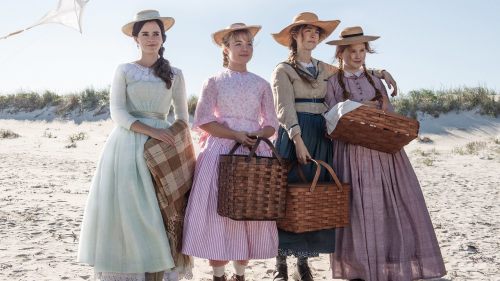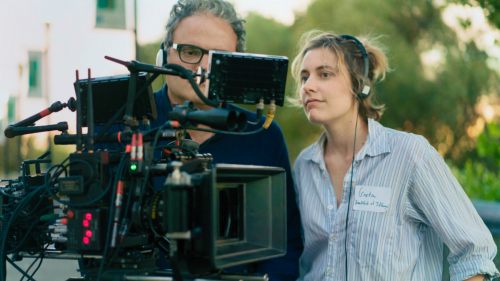LADY BIRD’s Love Letter to the Early Aughts
Rife with relevance and relatability, writer/director Greta Gerwig’s solo directorial debut Lady Bird is a film for all. It’s hysterical, sentimental, personal and accessible. But it stands out in its ability to capture the time it inhabits. All rise for the return of the early aughts.
The last decade has seen an influx of ‘90s-set period films (Straight Outta Compton, The Wolf of Wall Street, Dallas Buyers Club) that have unequivocally established the recent decade as historical. But Gerwig is ready to take the next step. Lady Bird might be the first to treat the unfortunately-named aughts (or, 00s) like a passed period. Granted, we should all be primed for carrying out a citizen’s arrest as soon as someone declares 2009 a historical relic in 2017. But in an age of exponential growth, seven years makes all the difference. Suddenly, now that we think about it, 2002 has lost its contemporary vibes.
Production designer Chris Jones and costume designer April Napier constructed the 2002 milieu that the film is soaked in. At the first sighting of a bulky flip phone, we feel like we’ve traveled back in time. We can feel the fist-sized brick in our hand and remember the strange pixelated pleasure it brought us. Likewise, the tacky trend of overlaid, incompatible jewelry on every appendage sticks out immediately as it adds an extra pound to the beloved “Lady Bird” (Saoirse Ronan) herself.
Gerwig, Jones, and Napier found a way to brand everyone on screen with a 2002 stamp of verification. Archetypes like Theatre Boy, Nerd, and Popular Girl wear their 2002 time stamp in dress, attitude, and interest. The Popular Boy is caught up reading or ranting about A People’s History of the United States everywhere we see him, yet embodies an attitude of ironic carelessness. The Popular Girl is constantly concerned with how short of a skirt she can get away with at their Catholic school. The Working Class Mom drives a neutral-colored ‘90s sedan that’s built to be unimpressive. Gerwig works 2002 teenage music culture in via Dave Mathews Band’s “Crash into Me.” Upon first listen we laugh and reminisce, but on second listen we fall into the same hyper-emotional dreamy trance it once held for many.
Lady Bird is practically penned with the zeitgeist of the early aughts, the period which brought about the first teenage millennials. There’s more material there than anyone knows what to do with, yet Gerwig maintains a focused eye. She balances her semi-autobiographical story between affection and comedic sympathy towards the period, never shying away from a chance to lovingly poke fun. She blatantly laughs at it all while simultaneously swooning over the reality it once was for her. Those of us who sparred with our wonderful, but occasionally tetchy mothers amidst the social hell of grade school in the early aughts will find ourselves all too familiar with Lady Bird and her surroundings. It’s the subtleties in Abercrombie fashion, intellectual-cultural progression, adorning room posters, music, and the like that extract the very essence of the early aughts in every image, every sensation, every line.
Gerwig also manages to incorporate the woes of the period into the film flawlessly. I panged with sorrow at the general aura of sexual intolerance that corners a character into remaining closeted. No doubt, similar hostility towards queer folk lingers, but fifteen years has seen strides that 2002 couldn’t imagine in queer affirmation. In regards to other tragedies, 9/11 might as well have a proverbial acting credit for as many times as its referenced explicitly or obliquely dealt with, and this is no exaggeration on Gerwig’s part. 2002 was replete with any and everything 9/11. Without threatening offense or even a political statement, Gerwig depicts the way that its mention became mundane to your average high schooler via unobserved moments of silence over the intercom—comparable to equally disregarded moments of prayer in Lady Bird’s Catholic high school—quickly transforming into opportunities to flirt. Whether it was the phrase “never forget” spelled out on a tack board in Lady Bird’s classroom, a casual conversation in which everyone despairingly nods for a few seconds before going onto the next subject, or the sudden impetus for popular assholes to feign national and political interest, Lady Bird captures the way 9/11 played into daily 2002 life.
At the local premiere of Lady Bird in Sacramento, Gerwig told viewers that the film is a “love letter to Sacramento.” Ultimately, her film is more than just a manifestation of adoration for her hometown which she boldly, and rightly, left behind. Gerwig beckons her fellow millennials back to the period that most critically shaped them in their teenage years. Among other things, Lady Bird is an endearing expression to the time period that it embraces. It is a love letter to the early aughts.


